Producers have a lot to consider when deciding when to start planting wheat — moisture, soil temperature, Hessian fly-free dates and more. Based on research from Kansas State University, another one of these considerations may appear small, at least physically, but could have a big impact come harvest — coleoptile length.
When a wheat seed germinates, one of the first structures to emerge from the seed after the seminal roots is the coleoptile. This plant part is a rigid protective structure that covers the emerging shoot of a wheat plant. As the wheat plant develops, this covering continues to elongate as the young seedling pushes through the soil until it breaks the surface and reaches sunlight. Then, the coleoptile stops growing and the first true leaf emerges through it.
However, if a wheat seed is planted too deep or into the wrong soil conditions, the coleoptile may not be able to break through the soil, leading to a variety of compounding issues for wheat stand establishment. In this case, when the coleoptile is unable to emerge, the first true leaf may emerge underneath the soil’s surface. Then, the leaf takes on an accordion-like appearance, the wheat plant typically becomes yellow and eventually the plant dies. Even if the plant survives, it has limited access to nutrients and sunlight and will result in lower yields.
So how do producers prevent this situation? First, according to a recent Wheat Rx publication by K-State Research and Extension, wheat should never be planted deeper than the coleoptile length of the wheat variety. In dryland environments like western Kansas, producers often “dust in” their wheat or plant into dry soil and rely on deeper subsoil moisture, requiring deeper planting depths. To succeed in this common scenario, farmers should select wheat varieties with longer coleoptile lengths that will help the wheat plant make it from the deeper planting to the soil surface.
An additional consideration is soil temperature. Planting wheat too early into warm soil temperatures can further reduce the coleoptile length. Some varieties will not germinate when soil temperatures are greater than 85°F and coleoptile length can be reduced by as much as 60 percent in higher temperatures. K-State recommends that if producers choose to plant in warmer soil temperatures, plant at a shallower depth (3/4 to 1 inch deep), even if moisture is absent in the top layers of soil. Planting wheat deep (greater than 2 inches) increases the risk of poor emergence and unacceptable stands.
By understanding the temperature sensitivity and coleoptile length of their selected wheat varieties, producers have one more tool to help them decide when to plant and how deep to promote better wheat stand establishment.
View the full list of ratings for coleoptile length for Kansas wheat varieties and find other recommendations based on the latest K-State research at kswheat.com/wheatrx. Wheat Rx is a series of Extension publications and other educational outreach materials designed to address key management areas of hard winter wheat. These publications contain recent data based on novel research funded in part by wheat farmers through the Kansas Wheat Commission’s two-cent wheat assessment.



